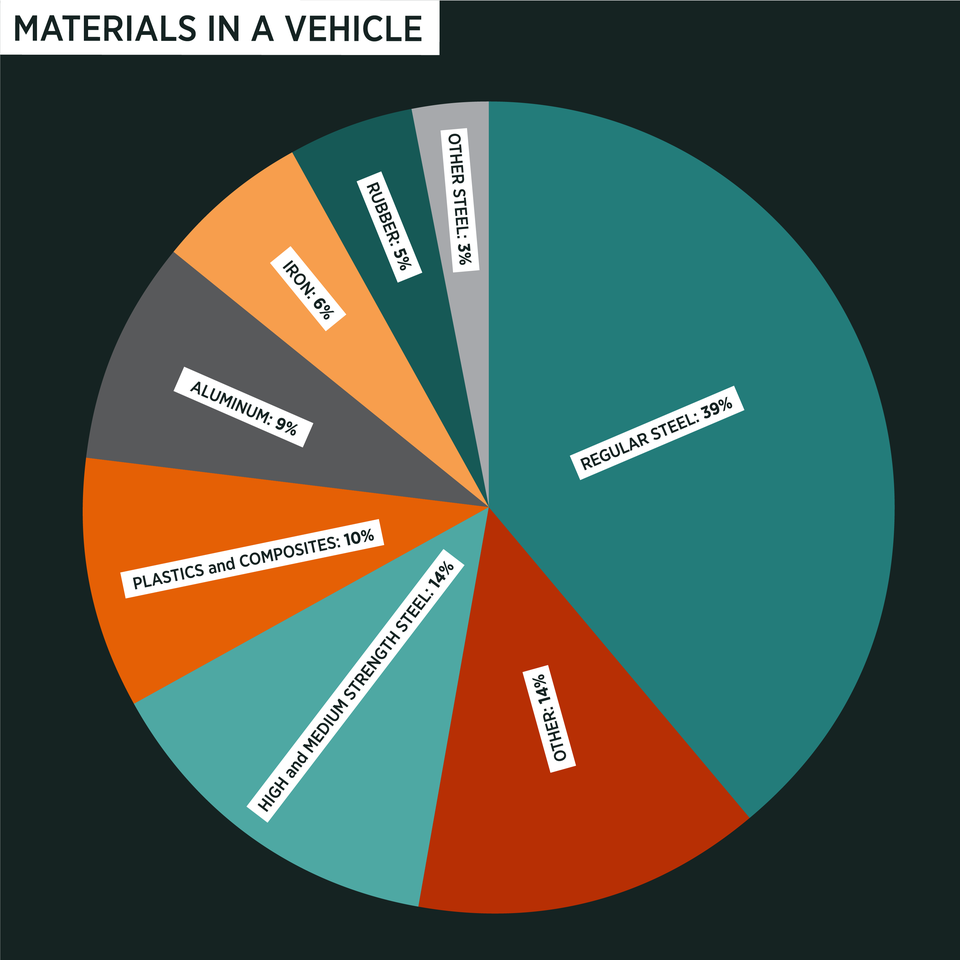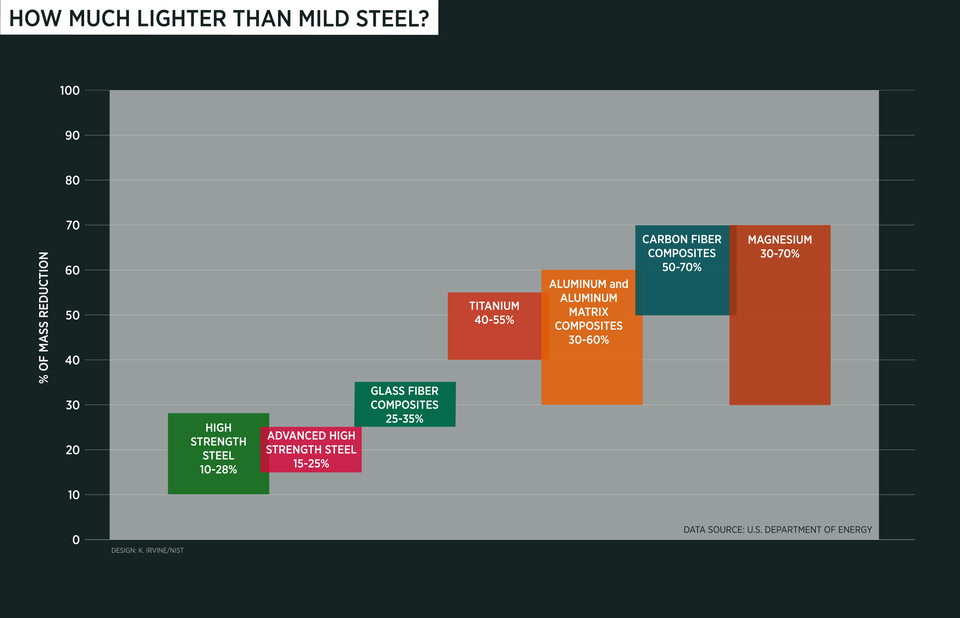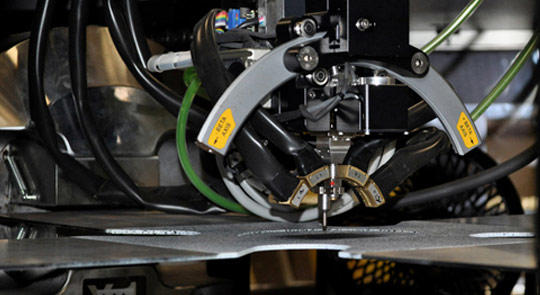
New NIST Research Center Helps the Auto Industry 'Lighten Up'
At the new NIST Center for Automotive Lightweighting (NCAL), workloads are fraught with stress and strain—all to help the auto industry to take a heavy load off future cars and light trucks.
To meet proposed federal fuel-efficiency standards—54.5 miles per gallon by 2025, or nearly double today's standard—the industry is trimming heft from its vehicles, largely by substituting newer, lighter materials and through vehicle redesign. A 10 percent reduction in mass translates into estimated fuel savings of 6 to 7 percent.
And as they transition to new types of steel, aluminum, magnesium, composites and other lightweight options, automakers and their suppliers are turning to NCAL for information key to the manufacturability of these materials. Center-supplied information also guides design decisions that will impact the performance, durability and crashworthiness of future cars and trucks.
The NIST research center specializes in measuring how the new materials are strained in response to the stresses of forming operations that shape the materials into hoods, fenders, door panels, floor pans and other parts. It also studies how the new materials will hold up in collisions, which is strongly influenced by material type and part shape.

Energy Advantages of Shedding Weight
Lighter vehicles need less energy—fuel or electric power—to overcome inertia and the forces that oppose movement, such as tire friction. For example, trimming body weight, which accounts for about a fourth of a car’s mass, opens the way to additional energy savings, achieved through:
- Smaller engines or batteries
- Reduced weight of tires, suspension and braking systems, and other components
- Decreases in energy required to speed up or slow down
- Reduced energy required to maintain a steady speed

Stress and Strain
To understand stress and strain in materials—NCAL’s main focus—consider an analogy.
To finish an awful job with an unreasonable deadline, you work under boss-exerted pressure. Your pulse quickens, eyes redden, and your stomach is in knots. You are showing strain under stress.
Materials behave similarly. For example, during manufacturing, a stamping press exerts force on a metal sheet. The sheet is under tension and compression; it is stressed. In response, the material changes in size and shape. This dimensional change is the strain—or deformation—caused by the stress.
Ranging from ultra brittle to extremely ductile, materials vary greatly in strain responses to increasing stress—and, thus, in manufacturability and crashworthiness.
"The better you understand the materials that you use, the better the design of the car and, ultimately, the better the car you build," explains Tim Foecke, the NIST metallurgist who directs the lightweighting center.
To reach the 2025 standard, automakers aim to cut from a few hundred pounds to upwards of half a ton off the weight of domestic light vehicles, now averaging almost 4,000 pounds. This means lots of changes are in store for automobile manufacturing over the next decade or so.

Managing by the Gram
Car companies aim to exploit every cost-effective opportunity to reduce weight and, with it, fuel consumption. So, nearly every vehicle detail is becoming a weighty one—so much so that automakers are beginning to "manage by the gram," according to one industry insider.
"We are light-weighting every aspect—body, chassis, interior and powertrain," says Cedric Xia, materials scientist at Ford's Research & Innovation Center.
In particular, "lightweight materials are important for reducing the mass of the body of the vehicle, which opens the way to other weight-saving strategies," Xia explains.

Lighter bodies, he adds, mean that auto manufacturers can downsize other parts of vehicles, from batteries, engines and transmissions to brakes and tires. Unfortunately, the new materials rarely behave predictably. They are more complex in chemical composition and internal structure than mild steel, the auto industry's material of choice for about a century. The industry has generations of hard-won experience and "rules of thumb" for shaping mild steel—how sharp a bend can you make in a steel sheet in a single operation without incurring too much damage, for example. But vehicle designers and tool makers can't count on the new high-tech materials to adhere to the old formulas and models.
New metals, for example, are lighter and stronger. This means they can sustain more collision forces, if properly engineered. But it also means that they resist the stress of twisting, stretching and squeezing, making them fussier to press into desired shapes.
"There can be lots of problems," says Xia, who ranks difficulties in controlling dimensional accuracy at the top. And if the materials don't behave as desired, manufacturing costs can soar, hiking the final price of vehicles. Consequences of the lack of reliable data to guide manufacturing can be unanticipated tears, wrinkles, buckling and other defects that can doom a part to the scrap bin or cause it to fail in a crash. Perhaps the most nettlesome problem of all is the increased tendency for "springback"—or the penchant of stronger materials to return to their original shape after stretching or squeezing.
This tendency means that forming processes must be designed in a way to essentially over-deform the part so that it springs back to the correct shape. Information gathered in NCAL experiments will help manufacturers to determine precisely how much more, which now is exceedingly difficult to predict.
Specifically, the center delivers reliable materials data, improved measurement capabilities, test methods and better understanding of the underlying mechanisms at work as a particular material is stressed—during manufacturing or a collision. NCAL partners include auto companies; steel, aluminum and polymer composite suppliers; national laboratories; and universities.
Putting Science to Work
Focusing initially on lightweighting metals, Foecke and his colleagues are building comprehensive understanding of how the materials deform during, for example, high-speed stamping or rolling processes. This knowledge will make the transition to new materials more efficient, requiring far less trial-and-error testing than is the case today and saving time and money.
Ultimately, Foecke says, the aim is to take all of the guess work out of forming processes and to turn the job entirely over to computers. This ambitious target has existed for decades, at least since 1977. That's when Harvard professor Bernard Budiansky shared his ultimate vision for stamped auto parts with a group of auto industry scientists and engineers.

In situ stress measurement on cruciform sample
Budiansky imagined a "computation black box into which we could feed a mathematical description of a [part's] shape, the thickness of the sheet and then push a button. The computer then spits out the die shape, the blank configuration," and so on.
Budiansky's bottom line: "If it's possible to make the part, the computer tells us this. If it's not possible, it tells us that, too!"
For now, Foecke and his team are willing to share the job with computers, while still pursuing Budiansky's goal. "A 50 percent—or even a 20 percent—reduction in testing could save millions in front-end development costs and precious time in meeting deadlines," he says.
Novel Instrumentation
Center research is conducted on an exceptional collection of equipment assembled—and, in some cases, designed—by the NCAL team. Funded, in part, by the American Recovery and Reinvestment Act, instruments range from the ordinary—such as standard tensile-testing equipment found in factories—to the unique—such as NIST's Next-Generation Formability System.
The recently commissioned $1.5 million formability system is the centerpiece of the 7,000-square-foot NCAL facility. Instrumented to the hilt, it has the capabilities of an unrivaled contortionist. The system can simultaneously and precisely stretch and compress samples in several directions, mimicking actual forming processes.
Until now, stress testing has largely been limited to stretching or squeezing samples in one direction, yielding an incomplete picture of the forming process. This shortcoming will become an even greater impediment as part designs become more complex—driven by a push to cut weight by consolidating parts and to make them more aerodynamic—and forming processes become more involved, often carried out in several stages.
At the National Center for Automotive Lightweighting, industry-submitted material samples—four-foot by four-foot sheets stacked like reams of paper in the lab—undergo the material-engineering equivalent of a thorough medical exam, complete with X-rays that capture atoms tearing apart under stress.
Results of the checkup are shared with NCAL's industry and academic partners. They compare the NCAL results with those from their computer models. Oftentimes, there is little resemblance between the two. The upshot is that, as is, the models won't provide much useful guidance on how to shape a promising lightweight material into a fender or other finished part.
And uncertainty also can be the cause of extra pounds. Because of unknowns about crash performance, for example, some structural car parts may be designed to be thicker and heavier than necessary—just to be on the safe side.
Practical Benefits
NCAL-furnished results already are making a difference.
"When metal sheets are pulled in multiple directions, we're finding that material properties can change in surprising ways—not the way models say they will," says Foecke.
Under the force of a press, steels will harden, the result of misaligned atoms moving in the material's crystal structure. In mild steel, such hardening is assumed to be a straightforward process.
But according to tests performed under the scrutiny of the Next-Generation Formability System, strain hardening can be especially tricky in advanced high-strength steels. Simultaneous stresses generate nonlinear strain paths that traverse different regions of a lightweight steel sheet, kind of like a topographic map showing features with different elevations. Zones of low and high strength may dot the part, depending on how it is shaped.
Complex strain paths, in turn, influence how much the sheet will stretch and thin during forming operations, how strong it is at certain locations and how much residual stress will remain after forming. All of these variables impact design and, ultimately, manufacturing and crash performance.
NIST's results on nonuniform hardening behavior helped to explain difficulties that the industry has been encountering in trial forming operations using high-strength steels, potentially removing a barrier on the road to lighter cars and trucks.
In addition, NCAL studies of a new type of flexible—or highly ductile—steel identified previously unrecognized variations in crystal structure that, at times, made the material less stretchable than expected. This information has helped to guide production of sheets of the material (known as TRIP steel) to ensure the uniform microstructure responsible for the enhanced stretchability.
Better materials characterization pays multiple dividends that reduce the cost of development and manufacturing, according to Ford's Xia. More can be accomplished through modeling and simulation, die design and performance can be improved, and even "more robust welding" methods may result, he says.
In the end, Xia hopes that by immersing itself in the intricate details of metal forming, NCAL will come up with Standard Reference Materials and simplified formability tests that automakers and their suppliers can put to work in their own factories and mills. And that is precisely what the NCAL team intends to do.
At the same time, Xia says NCAL-generated materials data should be shared broadly, but especially with university researchers who might use the data to develop materials models that will take more of the guess work and trial and error out of introducing new materials. "The auto industry is working with a sense of urgency. Collaboration is essential," Foecke says. "Companies don't have the time to solve the problem multiple times by working on their own. They've come together to meet this shared challenge. With our partners, we want to help them tackle it and solve the problem so they can move on to compete."
MEDIA CONTACT: alison.gillespie [at] nist.gov (subject: Lightweighting) (Alison Gillespie), 301-975-2316

